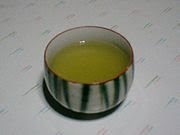Posted by me | Posted in | Posted on 10/31/2551


番茶 Bancha (common tea)
Sencha harvested as a third or fourth flush tea between summer and autumn. Aki-Bancha (autumn Bancha) is not made from entire leaves, but from the trimmed unnecessary twigs of the tea plant.
玄米茶 Genmaicha (brown-rice tea)
Bancha (sometimes Sencha) and roasted genmai (brown rice) blend. It is often mixed with a small amount of Matcha to make the color better.
玉露 Gyokuro (Jade Dew)
The highest grade Japanese green tea cultivated in special way. Gyokuro's name refers to the pale green color of the infusion. The leaves are grown in the shade before harvest, which alters their flavor. Gyokuro has a high caffeine content (Generally 0.16% in infusion[2]), but the significant L-Theanine content of Gyokuro slows down and counteracts the caffeine assimilation, and also the amount ingested is very small (Generally 10ml - 60ml).
焙じ茶 Hōjicha (roasted tea)
A green tea roasted over charcoal.
冠茶 Kabusecha (covered tea)
Kabusecha is sencha tea, the leaves of which have grown in the shade prior to harvest, although not for as long as Gyokuro. It has a more delicate flavor than Sencha.
窯煎茶 Kamairicha tea (pan-fried tea)
Kamairicha is a pan fried green tea that does not undergo the usual steam treatments of Japanese tea and does not have the characteristic bitter taste of most Japanese tea.
茎茶 Kukicha (stalk tea)
A tea made from stalks produced by harvesting one bud and three leaves.
かりがね Karigane
A tea made from stalks produced of sencha and gyokuro.
抹茶 Matcha (rubbed tea)
A fine ground tea (碾茶 Ten-cha). It has a very similar cultivation process as Gyokuro. It is used primarily in the tea ceremony. Matcha is also a popular flavor of ice cream and other sweets in Japan.
芽茶 Mecha tea (buds and tips tea)
Mecha is green tea derived from a collection of leaf buds and tips of the early crops. Mecha is harvested in spring and made as rolled leaf teas that are graded somewhere between Gyokuro and Sencha in quality.
麦茶 Mugicha (roasted barley tea)
Mugicha is a roasted barley tea. It is generally regarded as a cooling summer beverage in Japan.
煎茶 Sencha (broiled tea)
The first and second flush of green tea, which is the most common green tea in Japan made from leaves that are exposed directly to sunlight. The first flush is also called shincha (新茶: a new tea) and specially long steamed leaves mushicha (蒸し茶)
玉緑茶 Tamaryokucha
A tea that has a tangy, berry-like taste, with a long almondy aftertaste and a deep aroma with tones of citrus, grass, and berries.

Comments (0)
แสดงความคิดเห็น